Sukhoi T6-1
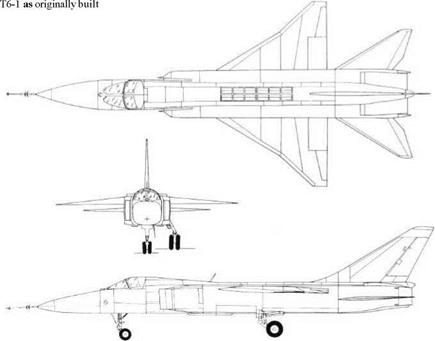
Purpose: To create a superior tactical attack bomber.
Design Bureau: P O Sukhoi, Moscow.
As noted in the story of the S-22I (S-32), publication of the formidable requirements for the USAF’s TFX programme spurred a response by the USSR. These requirements called for long range with a heavy bombload and the ability to make a blind first-pass attack at supersonic speed at low level ‘under the radar’. There was obvious need to replace the IL-28 and Yak-28, and the task appeared to call for either the use of a battery of special lift engines or a VG (variable-geometry, ie variable- sweep) wing. Sukhoi OKB was entrusted with this important task, and took a ‘belt and braces’ approach. To get something flying quickly it decided to put VG wings on the outstanding Su-7B, resulting in the S-22I described previously. For the longer term it launched development ofa new aircraft, the S-6. This was first drawn in 1963, and it was to have a fixed swept wing, two Metskvarichvili R-21F-300 engines each with a wet afterburning rating of 7,200kg (15,873 Ib), pilot and navigator seated in tandem, and the Puma navigation and weapon-delivery system. Five hardpoints were to carry a load of 3 tonnes (6,614 Ib), take-off weight being 20 tonnes (44,090Ib), and maximum speed was to be l,400km/h (870mph) at very low level and 2,500km/h (l,553mph, Mach 2.35) at high altitude. Shorttake-off capability was to be provided by two large take-off rockets. As a cover, and to assist
in obtaining funds more quickly, the S-6 was redesignated T-58M to look like a member of that interceptor family, but in 1964 it was terminated. This was partly because of in – tractible problems with the engine (see MiG Ye-8), and partly because of the good progress with the T-58VD (see previous). In early 1965 the S-6 was replaced by the T-6, later written T6. This was a significantly larger and more powerful aircraft, even surpassing the F-lll, which was in production by then. After rollout it was given the callsign Red 61 and first flown by the chief test pilot, Vladimir S Ilyushin, on 2nd July 1967. It was fitted with a battery of lift jets, as in the T-58VD, and it was immediately found that (as before) these caused aerodynamic and control difficulties. In 1968 the R-27 main engines were removed and the complete rear fuselage and powerplant systems modified to take the Lyul’ka AL-21F engine, with a maximum afterburning rating of 11,200kg (24,691 Ib). To improve directional stability the wingtips were tilted sharply down in TSR.2 fashion, the anhedral being 72°. Large strakes were added on each side of the rear fuselage, and the airbrakes deleted. To meet the needs of radar designers the nose radome was made shorter, with no significant effect on drag, and over the years numerous flush antennas and fairings appeared. Even after the decision was taken to change the design to have high-aspect-ratio ‘ swing wing s’ the T6-1 continued testing systems and equipment. In 1974, having made over 320 test flights, it was retired to the WS Museum at Monino.
In fact, the design ofthe T6-1 had been even more strongly influenced by the British TSR.2, with a fixed-geometry delta wing of short span and large area and fitted with powerful blown flaps. Before the first aircraft, the T6-1, was built the wing was modified with the leading – edge angle reduced from 60° to 45° outboard of the flaps, ahead of the conventional ailerons. As originally built, the large fuselage housed two Khachaturov (Tumanskii KB) R – 27F2-300 engines each with a wet afterburning rating of 9,690kg (21,3651b), fed by sharp-edged rectangular side inlets with an inner wall variable in angle and throat area. Downstream of the inlets the fuselage had a broad box-like form able to generate a considerable fraction of the required lift at supersonic speed at low level. Ahead of the inlets was an oval-section forward fuselage housing two K-36D seats side-by-side, as in the F-lll, an arrangement which was considered an advantage in a first-pass attack and also to assist conversion training in a dual version. There were left and right canopies each hinged upward from the broad spine downstream. The width of the cockpit left enough space between the engine ducts for a considerable fuel tankage as well as two pairs of RD-36-35 lift jets, installed in a single row as in the T-58VD. No attempt was made to bleed any engines to provide air for reaction-jet controls, because the T6-1 was not designed to be airborne at low airspeeds. The one-piece tailplanes were in fact tailerons, driven individually by KAU – 125 power units to provide control in roll as well as pitch. For operation from unpaved strips the levered-suspension main landing gears had twin wheels with tyres 900 x 230mm, retracting forwards into bays under the air ducts, while the steerable nose gear again had twin wheels, 600 x 200mm, with mudguards, retracting to the rear. At the extreme tail an airbrake was provided on each side, requiring a cutaway inboard trailing edge to the tailplanes, and between the jet nozzles under the rudder was a cruciform braking parachute. For the first time the avionics were regarded as a PNK, a totally integrated navigation and attack ‘complex’, and the T6-1 played a major role in developing this. It was fitted with four wing pylons with interfaces for a wide range of stores, as well as two hardpoints inboard of the main-gear bays, the maximum bombload being 5 tonnes (ll,0201b). The production Su-24 has eight hardpoints for loads up to 8 tonnes (17,637 Ib).
The T6-1 was a stepping-stone to a family of powerful and formidable aircraft which in 2000 are still in service with Russia and Ukraine. Unquestionably, the liftjets were not worth having.
![]()
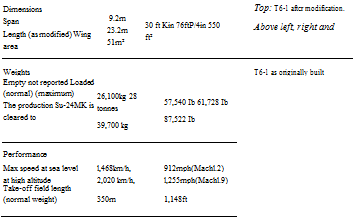 |

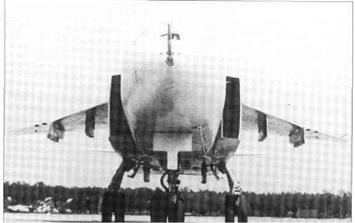
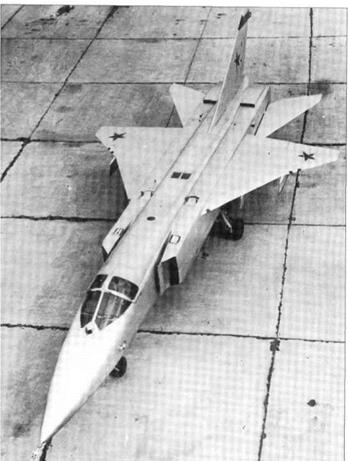

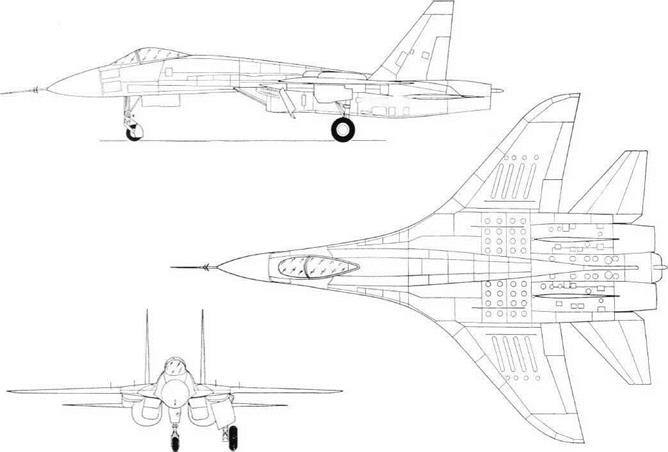 Purpose: To create a superior heavy fighter. Design Bureau: P O Sukhoi, Moscow.
Purpose: To create a superior heavy fighter. Design Bureau: P O Sukhoi, Moscow.
In 1969 the IA-PVO, the manned interceptor defence force, issued a requirement for a totally new heavy interceptor. This was needed to replace the Tu-128, Yak-28P and Su-15 in defending the USSR against various cruise missiles, as well as the F-l 11 and other new Western fighters and tactical aircraft. A specific requirement was to combine long-range standoff-kill capability with performance and combat agility superior in a close dogfight to any Western aircraft. The formal competition was opened in 1971. Though Mikoyan and Yakovlev were invited to participate, all the running was made by Sukhoi OKB, which was eager to move on from the T-4 and get a new production aircraft. With Sukhoi himself semi-retired, Yevgenii Ivanov was appointed chief designer, with Oleg Samolovich deputy. Sukhoi’s two rival OKBs made proposals, but did not receive contracts to construct prototype aircraft to meet this requirement (though the standoff-kill demand was also addressed by the later M1G-25P variants and MiG-31).
Sukhoi submitted two alternative proposals. Both were broadly conventional single-seat twin-engined aircraft with ‘ogival Gothic’ wings (almost delta-shape but with a doublecurved leading edge) and horizontal tails, the only new feature being twin vertical tails. One had side air inlets with horizontal ramps, while the other proposal had a fuselage blended into a wing mounted underneath and two complete propulsion systems mounted under the wing. A detail was that both had outstanding pilot view with a drooped nose and bulged canopy. As the wing was more akin to a delta than to a swept wing the project was given the designation T-l 0 in the T series (see T-3). The competitive design review was won by Sukhoi in May 1972. CAHI (TsAGI) had tunnel-tested T-10 models from 1969, and the work built up each year until 1974, demanding more tunnel testing than any previous Soviet aircraft except the Tu-144. It was the unconventional configuration that was chosen, with the fuselage tapering to nothing above the wing and being replaced by large engine gondolas underneath. Drawings for the first prototype, the
T10-1, were issued in 1975. Construction was handled by the OKB factory, except for wing and tail surfaces which were made at the OKB’s associated huge production facility named for Cosmonaut Yuri Gagarin at Komsomolsk-na-Amur in Siberia. Vladimir Ilyushin began a successful flight-test programme on 20th May 1977. Investigation of basic handling, including high-AOA (angle of attack) flight, was completed in 38 flights by late January 1978. Four wing fences were added, together with anti-flutter rods on the fins and tailplanes. Many further flights explored the FEW (fly-by-wire) flight controls and, after fitting no fewer than seven hard – points where pylons could be attached, the weapons control system. Red 10 was finally put on display in the Monino Museum. T10-2 began flying at the beginning of 1978, but a software error led to unexplored resonance which caused inflight breakup, killing Evgeny Solov’yov. By 1978 the OKB was busy with T10-3, the first prototype fitted with the definitive engine, and this was flown by Ilyushin on 23rd August 1979. In 1982 T10-3 was flown by OKB pilot Nikolai Sadovnikov from a simulated
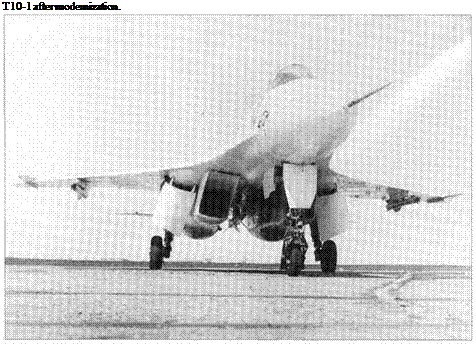
aircraft-carrier ramp, and it later made hook – equipped simulated carrier landings. T10-4, first flown by Ilyushin on 31st October 1979, tested the new engines and avionics. So great was the need to test avionics that the Komso – molsk factory was contracted to build five further prototypes. These were designated T10-5, -6, -9, -10 and -11 (T10-7 and -8 were significantly modified). These additional prototypes were generally similar to T10-3, apart from the fact that the fins were canted outwards. The T10-5 flew in June 1980, and the remainder were all on flight test by autumn 1982. Pavel Sukhoi died on 15th September 1975, and was succeeded as General Constructor by Mikhail P Simonov. Soon after he took over, the first detailed information on the McDonnell Douglas F-15 became available. Computer simulations found that the T-10 did not meet the requirement that it should be demonstrably superior to the USAF aircraft. Simonov ordered what amounted to a fresh start, telling the author ‘We kept the wheels and ejection-seat’. Designated T-10S, from Seriynii, production, the new fighter can only be described as brilliant. Ever since the first pre-series example, the T10-17, was flown by Ilyushin on 20th April 1981 it has been the yardstick against which other fighters are judged. An enormous effort was made by Nil using T10-17 and T10-22 to clear the redesigned aircraft for production. The first true series aircraft, designated Su-27, was flown at Komsomolsk in November 1982.
The T-10 wing had 0° dihedral, and a symmetric profile with a ruling thickness/chord ratio of 3.5 per cent, rising to 5 per cent at the root. The leading edge was fixed. It left the fuselage with a sharp radius and with a sweep angle of 79°, curving round to 41° over the outer panels and then curving back to Kiichemann tips. The main torsion box had three spars and one-piece machined skins. Most of the interior was pressurized and formed an integral tank, while high-strength ribs carried armament suspension points. The oval-section fuselage forward section was designed to accommodate the intended large radar, followed by the cockpit with a sliding canopy. Behind this came an equipment bay, followed by a humpbacked ‘forecastle tank’ and then a broad wing centre-section tank which could be considered as part of both the wing and fuselage. A further tank was placed in the keel beam between the engines. The latter were of the Lyul’ka AL-21F-3 type, each with an afterburning rating of 11,200kg (24,691 Ib). Each was placed in a large nacelle or gondola under the wing, tilted outward because of the inboard wing’s sharp taper in thickness. Each engine air duct was fed by a wedge inlet behind the leading edge, standing well away under the wing’s underskin to avoid swallow
ing boundary-layer air. Each inlet contained a variable upper ramp, with auxiliary side inlets for use on take-off, and a curved lower portion. The large engine gondolas provided strong bulkheads on which were mounted the two vertical fins and the tailplanes. The AL-21 had its accessories mounted on top, and the massive structure and fins immediately above made access difficult. From the third aircraft the engine was the Lyul’ka AL-31F, which had been specially designed for this aircraft. It had an afterburning rating of 12,500kg (27,557 Ib), and offered several other advantages, one being that it was half a tonne (1,100 Ib) lighter than the AL-21F. It had its accessories partly underneath and partly far forward on top, and the vertical tails were moved outboard away from the engine compartments. The main landing gears had large (1,030 x 350mm) tyres on single legs and retracted forwards, rotating the wheel through 90° to lie flat in the root of the wing in a bay closed by side doors and large front doors which served as airbrakes. The tall nose gear had a single unbraked wheel with a 680 x 260mm tyre. It retracted backwards, and was fitted with an all-round mudguard to protect the engine inlets. The main-wheel wells required a thick inboard section of the wing adjacent to the engine gondolas, and this was carried to the rear to provide strong beams to which the tailplanes (and in the redesigned aircraft the fins) were pivoted. The T-10 flight controls comprised conventional ailerons, two rudders and the independently controlled tailplanes. All these surfaces were driven by power units each served by both the completely separated 210kg/cm2 (2,987 lb/in2) hydraulic systems. These systems also drove the plain flaps, landing gears (with independent airbrake actuation), nosewheel steering,
engine inlets and mainwheel brakes. The flyby-wire system governed pitch control by the tailplanes used in unison, and provided three – axis stabilization. The mechanical controls worked directly by the pilot’s linkages to the surface power units governed the ailerons and rudder. The five internal fuel tanks were automatically controlled to supply fuel without disturbing the aircraft centre of gravity. A special oxygen system was provided to ensure engine restart and afterburner light-up at high altitude. T10-1 was built with no provision for armament, but in its modified state it had seven hardpoints on which external stores could be suspended.
Despite the fact that the basic aircraft had to be completely redesigned, the T-10 family of prototypes were stepping stones to the greatest fighter of the modern era.
|
Dimensions (T10-1 as built) Span Length Wing area |
14.7m 19.65m 59.0 nf |
48 ft 2V, ill 64 ft 5K in 635 a2 |
|
Weights |
||
|
Weight empty |
18,200kg |
40,123 Ib |
|
Loaded |
25,740kg |
56,746 Ib |
|
Performance |
||
|
Max speed at sea level, |
l,400km/h |
870 mph (Mach 1.145) |
|
at high altitude; |
2,230 km/h |
1,386 mph (Mach 2.1) |
|
Service ceiling |
17,500m |
57,415ft |
|
Range |
3,100km |
1,926 miles |










